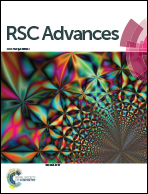Ultrasmall copper nanoclusters with multi-enzyme activities†
Abstract
Reactive oxygen species (ROS) as a key messenger of signal transduction mediate physiological activities, however, oxidative stress produced by excessive ROS can cause the destruction of cell homeostasis, which will result in a series of diseases. Therefore, effective control of ROS level is critical to the homeostasis of the cell. Here, we reported that glutathione (GSH)-stabilized copper nanoclusters (CuNCs) with about 9 Cu atoms can functionally mimic three major antioxidant enzymes, namely catalase (CAT), glutathione peroxidase (GPx) and superoxide dismutase (SOD). The rate of H2O2 decomposition was calculated to be ∼0.23 mg L−1 s−1 when the concentration of CuNCs was 100 μg mL−1. The SOD-like activity by catalyzing the disproportionation of superoxide  to H2O2 and O2 reached 25.6 U mg−1 when the effective inhibition rate was ∼55.4%. Intracellular ROS scavenging studies further identified that CuNCs can obviously protect cells from oxidative stress and the cell viability recovered to above 90%. Hence, we expect that ultrasmall CuNCs will provide good therapeutic potential in the future treatment of ROS-related diseases.
to H2O2 and O2 reached 25.6 U mg−1 when the effective inhibition rate was ∼55.4%. Intracellular ROS scavenging studies further identified that CuNCs can obviously protect cells from oxidative stress and the cell viability recovered to above 90%. Hence, we expect that ultrasmall CuNCs will provide good therapeutic potential in the future treatment of ROS-related diseases.



 Please wait while we load your content...
Please wait while we load your content...